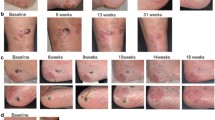Abstract
Purpose
Melanoma is one of the highly immunogenic malignancies, and histological regression (HR) and tumor infiltrating lymphocytes (TILs) represent early signs of activation of the immune system against primary melanoma. In this study we aimed to investigate the potential roles of HR and TILs on survival, as combined or separately.
Methods
A total of 916 cutaneous melanomas were analyzed retrospectively.
Results
Only minority of the lesions had HR (25.1%) and they were associated with males (p = 0.002), axial localization (p = 0.0001), non-nodular histopathology (p = 0.0001), thin Breslow depth (p = 0.01) and nevus-associated melanoma (p = 0.03). Those with TILs (48.4%) were found in association with lower Clark levels (p = 0.003), thin tumor thicknesses (p = 0.001), lower mitotic rates (p = 0.02), BRAF mutation (p = 0.03), absence of neurotropism (p = 0.03), involvement of lymph node (p = 0.0001) and relapse of disease (p = 0.04). A significant relationship was found between HR and TILs (p = 0.01). TILs were independently associated with favorable RFS (p = 0.02), whereas no relationship was observed between HR and RFS (p = 0.2). A marked favorable survival advantage was noted in the group with HR (+)/TILs (+) compared to other groups with HR (−)/TILs (−) (p = 0.007), only HR (+) and only TILs (+). Both HR (p = 0.05) and TILs (p = 0.04) were correlated with favorable OS rates. Moreover, HR (+) /TILs (+) patients had more favorable OS than other groups with HR (−)/TILs (−) (p = 0.002), only HR (+) and only TILs (+).
Conclusion
Only HR (+) and only TILs (+) subgroups separately were found to be associated with favorable survivals in melanoma. Furthermore, coexistence of HR and TILs, HR (+)/TILs (+) subgroup, had more favorable survival rates compared to only HR (+) and only TILs (+) subgroups.








Similar content being viewed by others
References
Attrill GH, Ferguson PM, Palendira U, Long GV, Wilmott JS, Scolyer RA (2020) The tumour immune landscape and its implications in cutaneous melanoma. Pigment Cell Melanoma Res, Sep 16
Azimi F, Scolyer RA, Rumcheva P et al (2012) Tumor-infiltrating lymphocyte grade is an independent predictor of sentinel lymph node status and survival in patients with cutaneous melanoma. J Clin Oncol 30:2678–2683
Burton AL, Gilbert J, Farmer RW et al (2011) Regression does not predict nodal metastasis or survival in patients with cutaneous melanoma. Am Surg 77:1009–1013
Guitart J, Lowe L, Piepkorn M et al (2002) Histological characteristics of metastasizing thin melanomas: a case-control study of 43 cases. Arch Dermatol 138:603–608
Morris KT, Busam KJ, Bero S, Patel A, Brady MS (2008) Primary cutaneous melanoma with regression does not require a lower threshold for sentinel lymph node biopsy. Ann Surg Oncol 15:316–322
Osella-Abate S, Conti L, Annaratone L et al (2019) Phenotypic characterization of immune cells associated with histological regression in cutaneous melanoma. Pathology 51:487–493
Ribero S, Osella-Abate S, Sanlorenzo M et al (2013) Favourable prognostic role of regression of primary melanoma in AJCC stage I-II patients. Br J Dermatol 169:1240–1245
Socrier Y, Lauwers-Cances V, Lamant L et al (2010) Histological regression in primary melanoma: not a predictor of sentinel lymph node metastasis in a cohort of 397 patients. Br J Dermatol 162:830–834
Tas F, Erturk K (2016) Presence of histological regression as a prognostic factor in cutaneous melanoma patients. Melanoma Res 26:492–496
Tas F, Erturk K (2017) Tumor infiltrating lymphocytes (TILs) may be only an independent predictor of nodal involvement but not for recurrence and survival in cutaneous melanoma patients. Cancer Invest 35:501–505
Taylor RC, Patel A, Panageas KS, Busam KJ, Brady MS (2007) Tumor-infiltrating lymphocytes predict sentinel lymph node positivity in patients with cutaneous melanoma. J Clin Oncol 25:869–875
Thomas NE, Busam KJ, From L et al (2013) Tumor-infiltrating lymphocyte grade in primary melanomas is independently associated with melanoma-specific survival in the population-based genes, environment and melanoma study. J Clin Oncol 31:4252–4259
Zaladonis AG, Farma JM, Hill M, et al. (2020) The role of tumor infiltrating lymphocytes and tumor regression in melanoma. ASCO 2020, Abstr: 87.10
Zugna D, Senetta R, Osella-Abate S et al (2018) Favourable prognostic role of histological regression in stage III positive sentinel lymph node melanoma patients. Br J Cancer 118:398–404
Funding
None.
Author information
Authors and Affiliations
Corresponding author
Ethics declarations
Conflict of interest
The authors declare that they have no conflicts of interest.
Additional information
Publisher's Note
Springer Nature remains neutral with regard to jurisdictional claims in published maps and institutional affiliations.
Rights and permissions
About this article
Cite this article
Tas, F., Erturk, K. Coexistence of regression and tumor infiltrating lymphocytes is associated with more favorable survival in melanoma. J Cancer Res Clin Oncol 147, 2721–2729 (2021). https://doi.org/10.1007/s00432-021-03565-y
Received:
Accepted:
Published:
Issue Date:
DOI: https://doi.org/10.1007/s00432-021-03565-y




